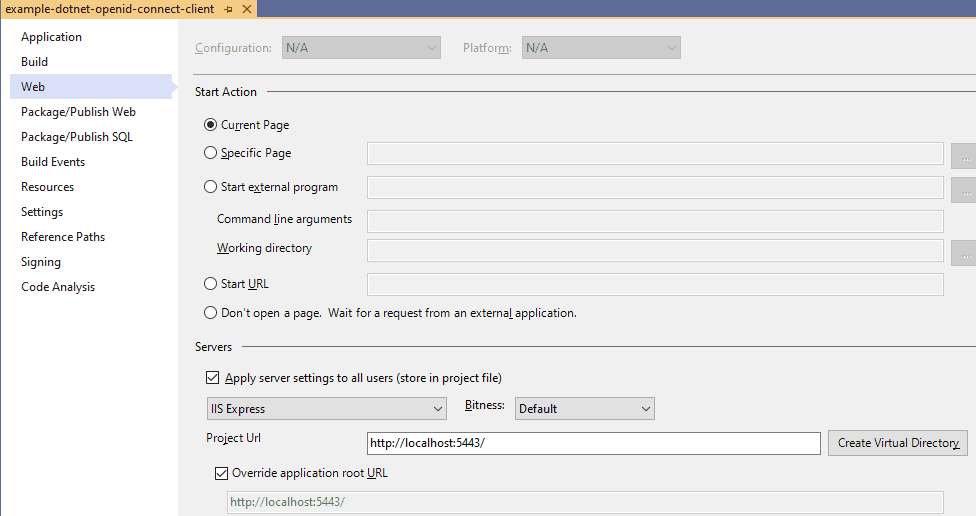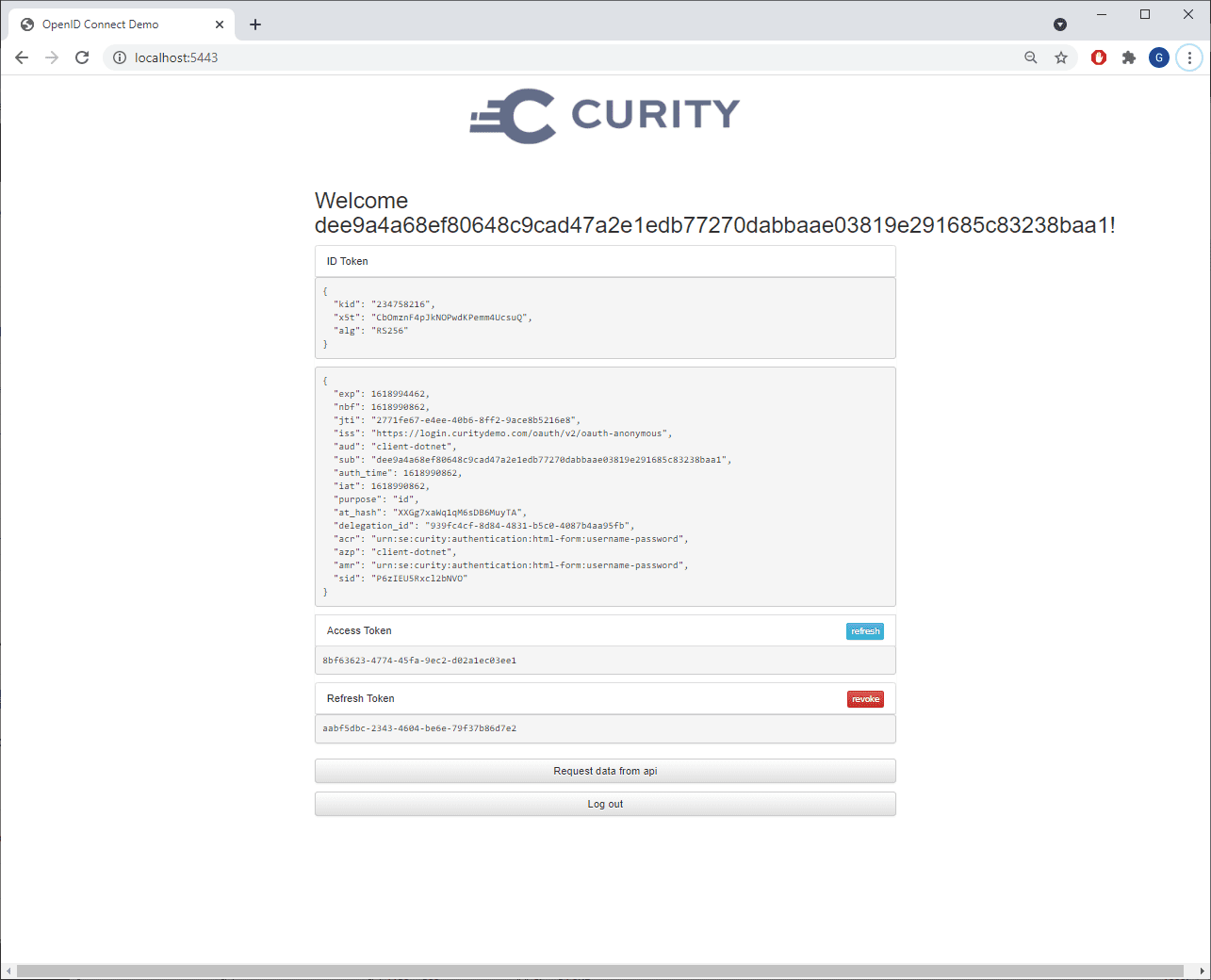On this page
Overview
This tutorial provides a basic demo application created using the .NET Framework, for websites hosted on Windows servers. The code shows how to implement an OpenID Connect flow to obtain access and ID tokens from an OpenID Provider.
Note
The example uses the Curity Identity Server, but you can run the code against any standards-based authorization server.
Configure the Curity Identity Server
In the Admin UI, create an OAuth Client with the following properties. Also ensure that at least one working authenticator is used, so that you are able to perform a user login once the sample is running.
- Client ID:
client-dotnet - Capabilities: Code Flow
- Authentication Method:
Secret - Client Secret:
Password1 - Redirect URI:
http://localhost:5443/callback - Post Logout Redirect URI:
http://localhost:5443 - scope:
openid read
Configure the Code Sample
The code sample uses .Net Framework 4.7 so ensure that this is installed and then use Visual Studio to open the code sample's .sln file. The configuration settings for the secured website can then be viewed:
<appSettings><add key="client_id" value="client-dotnet"/><add key="client_secret" value="Password1"/><add key="redirect_uri" value="http://localhost:5443/callback"/><add key="scope" value="openid read"/><add key="authorization_endpoint" value=""/><add key="token_endpoint" value=""/><add key="logout_endpoint" value=""/><add key="revocation_endpoint" value=""/><add key="jwks_uri" value=""/><add key="issuer" value="https://login.curitydemo.com/oauth/v2/oauth-anonymous"/><add key="api_endpoint" value="https://localhost:3000"/><add key="base_url" value="http://localhost:5443"/></appSettings>
The sample uses the following base URLs by default:
| Component | Base URL |
|---|---|
| Web Application | http://localhost:5443 |
| Curity Identity Server | https://localhost:8443 |
| API | http://localhost:3000 |
Under Web Properties we can see that the sample is configured to be hosted via IIS Express and to listen on port 5443:

Application Startup
When the code sample starts, it uses the discovery endpoint of the Curity Identity Server to load metadata describing all of the standard endpoints:
if (!String.IsNullOrEmpty(issuer)){var discoveryClient = new HttpClient();var response = discoveryClient.GetAsync(issuer + "/.well-known/openid-configuration").Result;if (response.IsSuccessStatusCode){string responseString = response.Content.ReadAsStringAsync().Result;JObject responseJson = JObject.Parse(responseString);authorization_endpoint = responseJson["authorization_endpoint"].ToString();token_endpoint = responseJson["token_endpoint"].ToString();revocation_endpoint = responseJson["revocation_endpoint"].ToString();logout_endpoint = responseJson["end_session_endpoint"].ToString();jwks_uri = responseJson["jwks_uri"].ToString();}}
Test Logins
The code sample can then be run from Visual Studio, and the browser then presents its initial screen, to enable the user to sign in:

The code implements OpenID Connect standard authentication redirect functionality by first forming a request URL with the standard parameters and redirecting the browser:
public String GetAuthnReqUrl(){return authorization_endpoint + "?client_id="+ client_id + "&response_type=code"+ "&scope=" + scope + "&redirect_uri=" + redirect_uri;}
Upon return, the .Net app receives an authorization code and swaps it for tokens using an authorization code grant message:
public String GetToken(String code){var values = new Dictionary<string, string>{{ "grant_type", "authorization_code" },{ "client_id", client_id},{ "client_secret", client_secret },{ "code" , code },{ "redirect_uri", redirect_uri}};HttpClient tokenClient = new HttpClient();var content = new FormUrlEncodedContent(values);var response = tokenClient.PostAsync(token_endpoint, content).Result;}
Use Access Tokens
The web back end then receives opaque access and refresh tokens, and operations on them can be tested from within the web app:

The C# application could verify received tokens and return data directly, though it is more common these days for a web back end to call APIs instead. No API is provided with the sample, but the HomeController class demonstrates how to make an outgoing call, by adding a bearer token to the HTTP Authorization Header:
String access_token = Session["access_token"].ToString();client.DefaultRequestHeaders.Authorization = new AuthenticationHeaderValue("Bearer", access_token);var response = client.GetAsync(api_endpoint).Result;Session["api_response_status_code"] = response.StatusCode;
To work with a real API you could adapt the .Net API Code Sample. For a full end to end solution an API Gateway should also be integrated, using the Phantom Token Pattern.
Logout
Finally the sample can be used to perform a logout operation, and to revoke tokens if required. A post_logout_redirect_uri value is supplied to ensure that the user is returned to the home page when the logout operation completes.
public class LogoutController : Controller{private static string client_id = App_Start.AppConfig.Instance.GetClientId();private static string logout_endpoint = App_Start.AppConfig.Instance.GetLogoutEndpoint();private static string base_url = App_Start.AppConfig.Instance.GetBaseUrl();public ActionResult Index(){Session.Abandon();string logout_request = $"{logout_endpoint}?client_id={client_id}&post_logout_redirect_uri={HttpUtility.UrlEncode(base_url)}";return Redirect(logout_request);}}
Conclusion
We demonstrated the basics of an OpenID Connect flow in C#, resulting in a web application that uses a number of standards based endpoints. This enables features for login, logout and working with tokens, including calls to OAuth secured APIs.

Join our Newsletter
Get the latest on identity management, API Security and authentication straight to your inbox.

Start Free Trial
Try the Curity Identity Server for Free. Get up and running in 10 minutes.
Start Free TrialWas this helpful?






